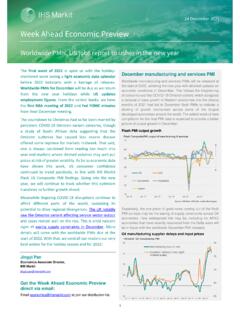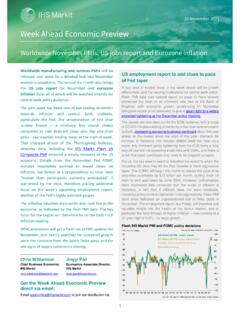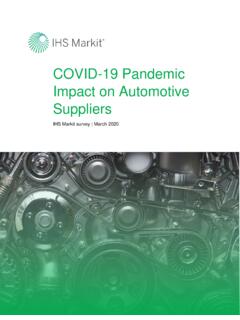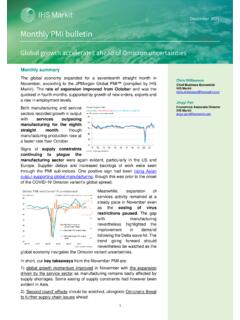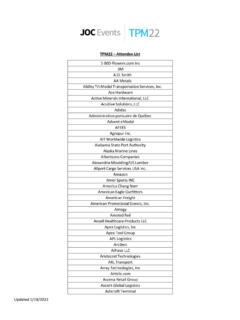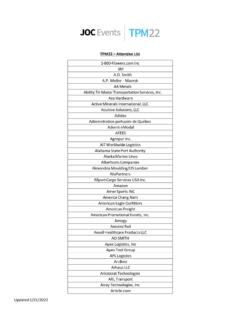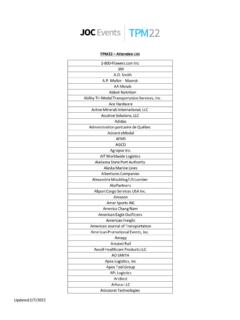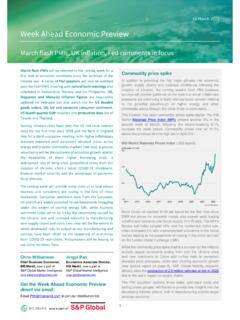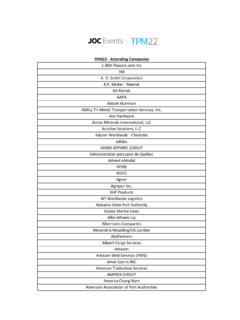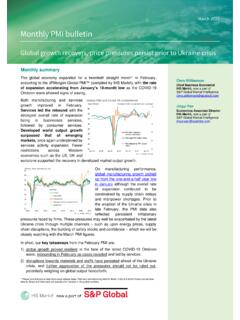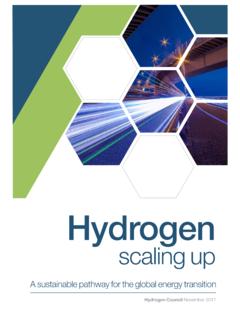Transcription of Pivoting to an Electrified Future
1 Pivoting to an Electrified FutureThe Automotive Industry Amps Automotive Industry Amps UpAs we emerge from the COVID-19 crisis, the automotive industry is Pivoting sharply to an Electrified Future . IHS Markit analyzes the drivers of this change and the new trajectory that the industry is following. The year 2027 emerges as a tipping point for an acceleration in EV adoption, and by 2030 over one in four new passenger cars sold will be an automotive industry is Pivoting toward an Electrified Future driven by the Paris COP-21 agreement and the intensification of green policy initiatives by country governments. The timetable for industry change is now led by legislation rather than the consumer with OEMs announcing aggressive target dates for zero tailpipe world has undergone two significant dislocations in recent years.
2 As of February 2021, 194 states and the European Union have signed the Paris Climate agreement (COP-21), which effectively sets the legislative framework for the decarbonization of the global economy. Policies targeting emissions from transportation, which amount to about one-third of overall greenhouse gas (GHG) emissions in the EU or the US, are becoming a central plank in governmental policy. In addition, as governments grapple with huge adjustments in their fiscal balances after the COVID-19 pandemic, an even greater relative focus has been placed on supporting low-carbon growth strategies. The COVID-19 crisis has arguably accelerated the promotion of Electrified vehicles as part of an overall green-friendly solution. Rather than resisting this trend, OEMs are now actively embracing it, with many planning to go completely electric.
3 In consequence, IHS Markit has significantly increased its forecasts for global electrification. The year 2027 emerges as a tipping point after which rates of electric vehicle (EV) sales will rise sharply. By 2030, one in four new passenger car sales will be fully electric. This article seeks to outline the key drivers of this new accelerated trend and their impact on the industry s propulsion choices. This high-level assessment of the forecast will be incorporated into each of the IHS Markit forecast product sets in the upcoming forces become irresistible The Paris accord set target levels for global decarbonization (see table). Achieving a target of a 55% reduction in greenhouse gas emissions by 2030 in the EU will require action across all sectors, including the three largest contributors of transport, industry, and power generation.
4 While the precise sectoral contributions to this target are somewhat fungible, it is clear that transport will need to be heavily decarbonized in the coming years in all the major industrialized economies. Legislation to this effect is now being tightened significantly in the three major geographies (US, Europe, and mainland China). Emissions Levels and Climate Change CommitmentsCountry/RegionAll sector emissions CO2 (mt CO2)Transport sector emissions CO2 (mt CO2)Transport sector (%)Net-Zero target dateTransport sector CO2 pledgeMainland China9, 65% carbon intensity reduction from 2005 levels by 2030US4,9211, 28% reduction by 2025 from 2005 levels. *EU3, zero goal for 2050, seeks 90% CO2 reduction from 1990 levels by 2050 for a sustainable transport systemSource: IEA, 2018 figures. At the time of writing the US was about to announce targets of up to 50% reductions on 2030 levels.
5 In Europe, CO2 targets for passenger cars by 2030 are now likely to move to a 55% reduction on 2021 levels as measured by the World Harmonized Light Vehicle Test Procedure (WLTP). The current target reduction is Although not formally agreed yet, IHS Markit analysts expect an EU-wide internal combustion engine (ICE) phase-out by 2040 or before. In fact, there are nine EU member states lobbying for a phase out by 2035 or earlier. Ultimately even more stringent CO2 measurements are likely to be adopted, which will include the entire manufacturing process. The EU will decide in 2023 on proposals to include this full Life Cycle Assessment (LCA) starting in 2026 27. OEMs are already beginning to adopt low-carbon supply chains; a recent signal of this is an agreement between Audi and Alcoa to source zero-carbon aluminum for its E-tron model wheels.
6 In the US, the Joe Biden administration is laying down strong markers that it is much more serious on climate change than the previous administration. It has rejoined the Paris accord and is pressing for significant decarbonization upstream in the fossil fuels industry. For example, the Securities and Exchange Commission (SEC) recently gave direction to Conoco Philips and Occidental Petroleum Corp to hold shareholder votes on far-reaching new emission targets. At the time of writing it was considering increasing its targets to around a 50% reduction on 2005 levels by 2030. Currently, in the automotive sector, the US is tied to the Safer Affordable Fuel-Efficient (SAFE) rules up to model year (MY) 2026. These rules require a relatively small increase in fuel economy in the five-year period to MY 2026.
7 Starting with MY 2027, IHS Markit analysts assume that the Biden administration will revert to the more stringent rules under the Barack Obama administration (starting at around mpg for passenger cars in 2027). Furthermore, IHS Markit analysts expect five states (California, Washington, Massachusetts, Rhode Island, and New York) will ban ICE vehicles by 2035. As seen with the decline of diesel in Europe (in that case, city-level banning of diesels), tight regional legislation can set the tone for a rapid decline across a whole market. Meanwhile, mainland China has committed to achieve net-zero emissions by 2060. From an automotive regulatory perspective mainland China is only a few years behind Europe. In 2026, the Phase 6 emission legislation for passenger vehicles will be introduced and could have quotas of 25% new-energy vehicles (NEVs).
8 NEVs are defined as pure battery-electric vehicles (BEVs) and plug-in hybrid vehicles (PHEVs). There could also be tighter Corporate Average Fuel Consumption (CAFC) fuel economy targets of for new vehicle sales. COVID-19, the unlikely electrification accelerator One of the side effects of the COVID-19 pandemic has been the increased focus on a low carbon policies by fiscally constrained governments. Examples of the fallout from the COVID-19 pandemic that are propelling EV adoption forward are: The European Green Deal. This strategy aims to provide the policy tools to ensure that the financial system supports the transition of businesses toward sustainability in a context of recovery from the impact of the COVID-19 outbreak. It will support the creation of an enabling framework for private investors and the public sector to facilitate sustainable investments.
9 Environmental, social, and corporate governance (ESG) compliance will have a direct impact on a company s ability to receive fresh capital from the financial markets. Commuter mobility. The slowdown in commuter traffic has led cities to install nonmotorized transport networks , dedicated bike lanes in Paris. City legislators are using the COVID-19 disruption to drive nonessential car use from their roads. Bonus-malus automotive policies. Countries are explicitly targeting low-emissions vehicles in their recovery plans for the automotive sector. In France, for example, subsidies of up to EUR7,000 per vehicle are available for the purchase of a zero-emissions vehicle. Equity markets. Massive spending by governments to support their economies is seeping into equity markets. Combined with the low-carbon transformation story, equity prices among EV-intensive OEMs have shot up.
10 At the time of writing (mid-April 2021) Tesla s capitalization of USD675 billion made it more valuable than the next five OEMs combined: Toyota (USD215 billion), Volkswagen (USD162 billion), Daimler (USD97 billion), General Motors (USD86 billion), and BYD (USD69 billion). Additionally, the use of special purpose acquisition companies (SPACs) to take emerging players such as Lucid, Fisker, Reev, and Arrival public has given the sector access to capital at levels unimagined just a few months ago. This capital can be deployed in investments that will accelerate the shift of the global industry toward EVs. The economic stars of EV adoption are aligning 2027 is a key tipping pointMeanwhile, the economic underpinnings for this EV revolution are beginning to align. Range anxiety is being addressed. As an example, the 2021 Nissan Leaf (62kWh) today has a WLTP certified range of 385Km.
